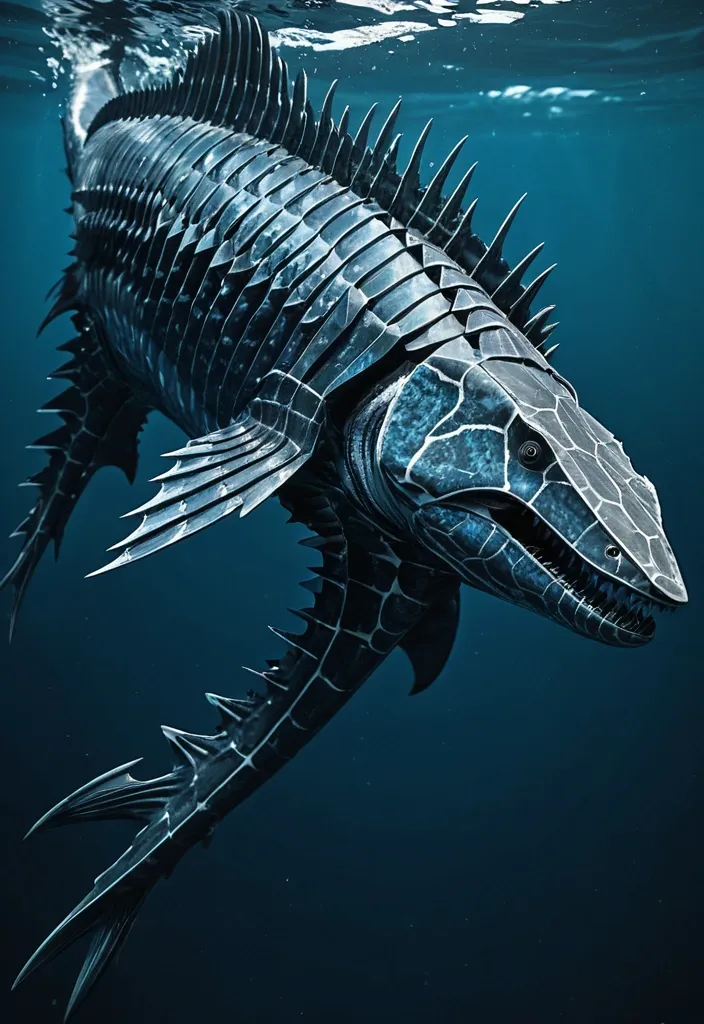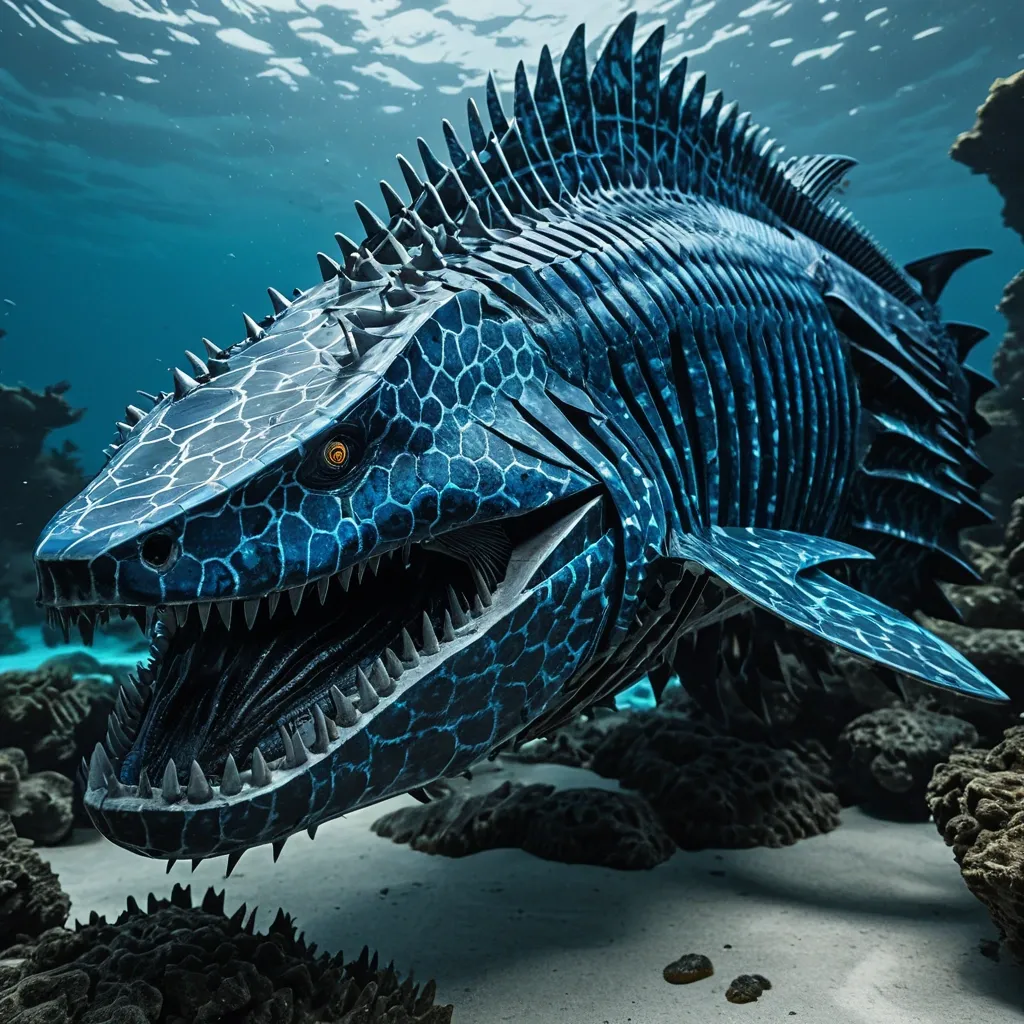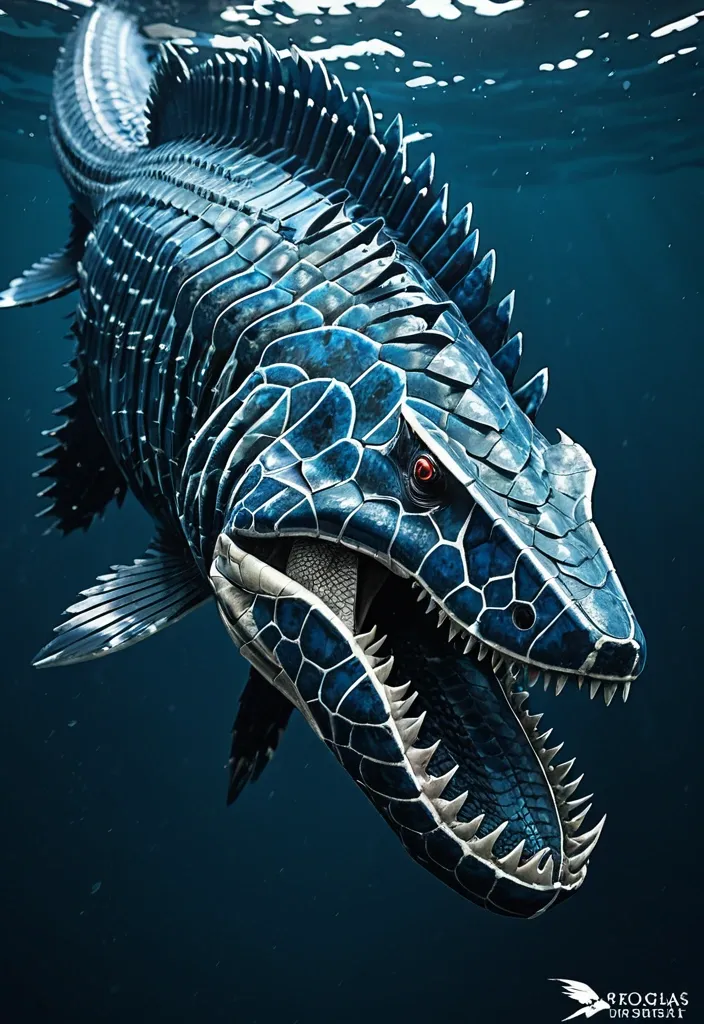Search Results for with an agile
Explore AI generated designs, images, art and prompts by top community artists and designers.

Orcinus Megalsaurus is a colossal marine hybrid stretching between 40 to 60 feet in length , weighing an imposing 50 to 75 tons. Its body is a streamlined fusion of powerful marine predators and ancient reptiles , designed for both speed and durability. Head & Jaws: Massive and robust jaws reminiscent of Mosasaurus Hoffmannii , lined with dozens of large , serrated teeth capable of slicing through the toughest prey. The jaw muscles are reinforced for crushing power , with an agile , flexible skull allowing it to swallow large creatures whole. Body: Covered in overlapping , bony , and tough Arapaima-inspired scales that provide formidable protection while maintaining flexibility for swift movement. The coloration is a gradient of deep oceanic blues and dark greys , with subtle mottled patterns for camouflage in deep waters. Spines & Armor: Sprouting venomous , long , sharp spines along its dorsal ridge , inspired by the Crown-of-Thorns starfish , these spines serve as both defense and offense , delivering painful , venomous wounds to predators or prey. Flippers & Tail: Enormous paddle-like front flippers derived from Archelon Ischyros , granting powerful swimming strokes. Its tail is flattened and ends in a strong fluke like the Mosasaurus , enabling bursts of speed up to 82 mph , matching the fastest sea animals. The tail's blubber and flexible musculature provide a springlike propulsion effect. Skin & Blubber: Beneath the scales lies a thick layer of dolphin-like blubber , providing insulation , buoyancy , and rapid healing properties. This blubber contains antimicrobial compounds that prevent infection from wounds and smooth the skin for hydrodynamic efficiency. Sensory & Communication: Equipped with the acute echolocation and vocalization abilities of Bigg’s Killer Whales , Orcinus Megalsaurus uses short-range , stealthy communication to coordinate ambush attacks. Its hearing and sonar are highly advanced , allowing it to detect prey at great distances. Mucus Secretion: When threatened , it can release a thick mucus cloud inspired by the Atlantic hagfish , confusing predators and protecting its skin from abrasion and parasites. Locomotion on Land: Although primarily aquatic , it can scoot or slide on land for short distances , using its powerful flippers akin to a leopard seal , allowing it to traverse beaches or shallow coasts. Regeneration: Thanks to the axolotl gene integration , Orcinus Megalsaurus can regenerate lost limbs , spines , and even parts of its internal organs , making it extraordinarily resilient. Abilities: Speed & Agility: Capable of reaching speeds of 45 to 82 mph in short bursts , making it one of the fastest marine predators ever. Its rigid pectoral fins can be tilted back like a black marlin to reduce drag during high-speed chases. Venomous Defense: Venomous spines deter attackers and can incapacitate prey or enemies with painful wounds. Stealth & Teamwork: Utilizes orca-like stealth and coordinated hunting tactics , ambushing prey with precision and communication that avoids detection. Healing & Immunity: Blubber layer accelerates wound healing and provides antimicrobial defense , ensuring survival from injuries sustained during hunts or fights. Mucus Defense: Can deploy mucus clouds to escape or confuse predators and parasites. Environmental Adaptability: Tolerates a wide range of salinity , from freshwater estuaries to deep oceanic waters , allowing it to exploit diverse hunting grounds. ,

Orcinus Megalsaurus is a colossal marine hybrid stretching between 40 to 60 feet in length , weighing an imposing 50 to 75 tons. Its body is a streamlined fusion of powerful marine predators and ancient reptiles , designed for both speed and durability. Head & Jaws: Massive and robust jaws reminiscent of Mosasaurus Hoffmannii , lined with dozens of large , serrated teeth capable of slicing through the toughest prey. The jaw muscles are reinforced for crushing power , with an agile , flexible skull allowing it to swallow large creatures whole. Body: Covered in overlapping , bony , and tough Arapaima-inspired scales that provide formidable protection while maintaining flexibility for swift movement. The coloration is a gradient of deep oceanic blues and dark greys , with subtle mottled patterns for camouflage in deep waters. Spines & Armor: Sprouting venomous , long , sharp spines along its dorsal ridge , inspired by the Crown-of-Thorns starfish , these spines serve as both defense and offense , delivering painful , venomous wounds to predators or prey. Flippers & Tail: Enormous paddle-like front flippers derived from Archelon Ischyros , granting powerful swimming strokes. Its tail is flattened and ends in a strong fluke like the Mosasaurus , enabling bursts of speed up to 82 mph , matching the fastest sea animals. The tail's blubber and flexible musculature provide a springlike propulsion effect. Skin & Blubber: Beneath the scales lies a thick layer of dolphin-like blubber , providing insulation , buoyancy , and rapid healing properties. This blubber contains antimicrobial compounds that prevent infection from wounds and smooth the skin for hydrodynamic efficiency. Sensory & Communication: Equipped with the acute echolocation and vocalization abilities of Bigg’s Killer Whales , Orcinus Megalsaurus uses short-range , stealthy communication to coordinate ambush attacks. Its hearing and sonar are highly advanced , allowing it to detect prey at great distances. Mucus Secretion: When threatened , it can release a thick mucus cloud inspired by the Atlantic hagfish , confusing predators and protecting its skin from abrasion and parasites. Locomotion on Land: Although primarily aquatic , it can scoot or slide on land for short distances , using its powerful flippers akin to a leopard seal , allowing it to traverse beaches or shallow coasts. Regeneration: Thanks to the axolotl gene integration , Orcinus Megalsaurus can regenerate lost limbs , spines , and even parts of its internal organs , making it extraordinarily resilient. Abilities: Speed & Agility: Capable of reaching speeds of 45 to 82 mph in short bursts , making it one of the fastest marine predators ever. Its rigid pectoral fins can be tilted back like a black marlin to reduce drag during high-speed chases. Venomous Defense: Venomous spines deter attackers and can incapacitate prey or enemies with painful wounds. Stealth & Teamwork: Utilizes orca-like stealth and coordinated hunting tactics , ambushing prey with precision and communication that avoids detection. Healing & Immunity: Blubber layer accelerates wound healing and provides antimicrobial defense , ensuring survival from injuries sustained during hunts or fights. Mucus Defense: Can deploy mucus clouds to escape or confuse predators and parasites. Environmental Adaptability: Tolerates a wide range of salinity , from freshwater estuaries to deep oceanic waters , allowing it to exploit diverse hunting grounds. ,

Orcinus Megalsaurus is a colossal marine hybrid stretching between 40 to 60 feet in length , weighing an imposing 50 to 75 tons. Its body is a streamlined fusion of powerful marine predators and ancient reptiles , designed for both speed and durability. Head & Jaws: Massive and robust jaws reminiscent of Mosasaurus Hoffmannii , lined with dozens of large , serrated teeth capable of slicing through the toughest prey. The jaw muscles are reinforced for crushing power , with an agile , flexible skull allowing it to swallow large creatures whole. Body: Covered in overlapping , bony , and tough Arapaima-inspired scales that provide formidable protection while maintaining flexibility for swift movement. The coloration is a gradient of deep oceanic blues and dark greys , with subtle mottled patterns for camouflage in deep waters. Spines & Armor: Sprouting venomous , long , sharp spines along its dorsal ridge , inspired by the Crown-of-Thorns starfish , these spines serve as both defense and offense , delivering painful , venomous wounds to predators or prey. Flippers & Tail: Enormous paddle-like front flippers derived from Archelon Ischyros , granting powerful swimming strokes. Its tail is flattened and ends in a strong fluke like the Mosasaurus , enabling bursts of speed up to 82 mph , matching the fastest sea animals. The tail's blubber and flexible musculature provide a springlike propulsion effect. Skin & Blubber: Beneath the scales lies a thick layer of dolphin-like blubber , providing insulation , buoyancy , and rapid healing properties. This blubber contains antimicrobial compounds that prevent infection from wounds and smooth the skin for hydrodynamic efficiency. Sensory & Communication: Equipped with the acute echolocation and vocalization abilities of Bigg’s Killer Whales , Orcinus Megalsaurus uses short-range , stealthy communication to coordinate ambush attacks. Its hearing and sonar are highly advanced , allowing it to detect prey at great distances. Mucus Secretion: When threatened , it can release a thick mucus cloud inspired by the Atlantic hagfish , confusing predators and protecting its skin from abrasion and parasites. Locomotion on Land: Although primarily aquatic , it can scoot or slide on land for short distances , using its powerful flippers akin to a leopard seal , allowing it to traverse beaches or shallow coasts. Regeneration: Thanks to the axolotl gene integration , Orcinus Megalsaurus can regenerate lost limbs , spines , and even parts of its internal organs , making it extraordinarily resilient. Abilities: Speed & Agility: Capable of reaching speeds of 45 to 82 mph in short bursts , making it one of the fastest marine predators ever. Its rigid pectoral fins can be tilted back like a black marlin to reduce drag during high-speed chases. Venomous Defense: Venomous spines deter attackers and can incapacitate prey or enemies with painful wounds. Stealth & Teamwork: Utilizes orca-like stealth and coordinated hunting tactics , ambushing prey with precision and communication that avoids detection. Healing & Immunity: Blubber layer accelerates wound healing and provides antimicrobial defense , ensuring survival from injuries sustained during hunts or fights. Mucus Defense: Can deploy mucus clouds to escape or confuse predators and parasites. Environmental Adaptability: Tolerates a wide range of salinity , from freshwater estuaries to deep oceanic waters , allowing it to exploit diverse hunting grounds. ,